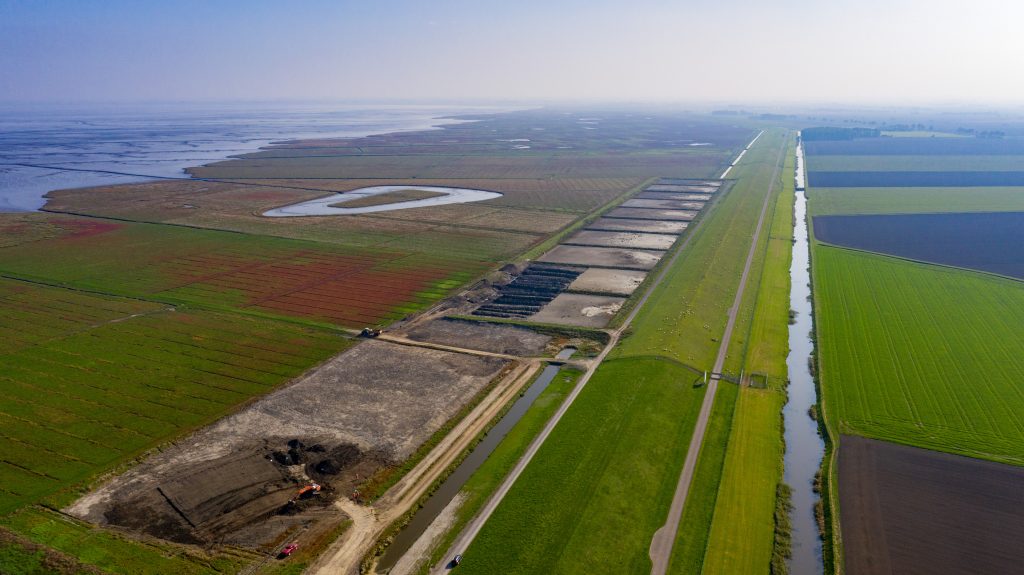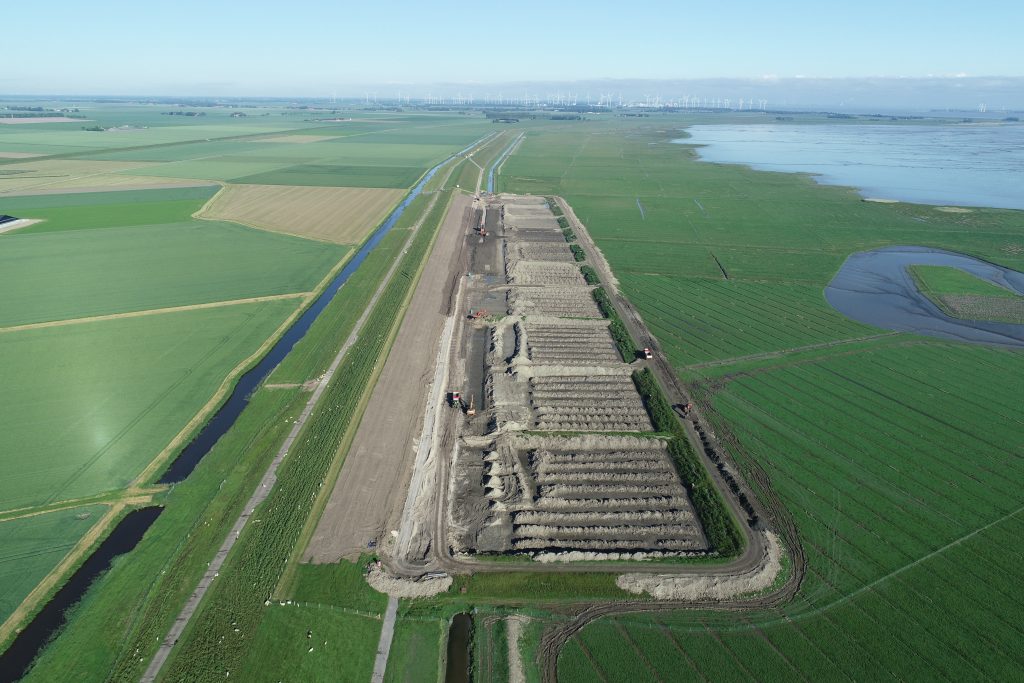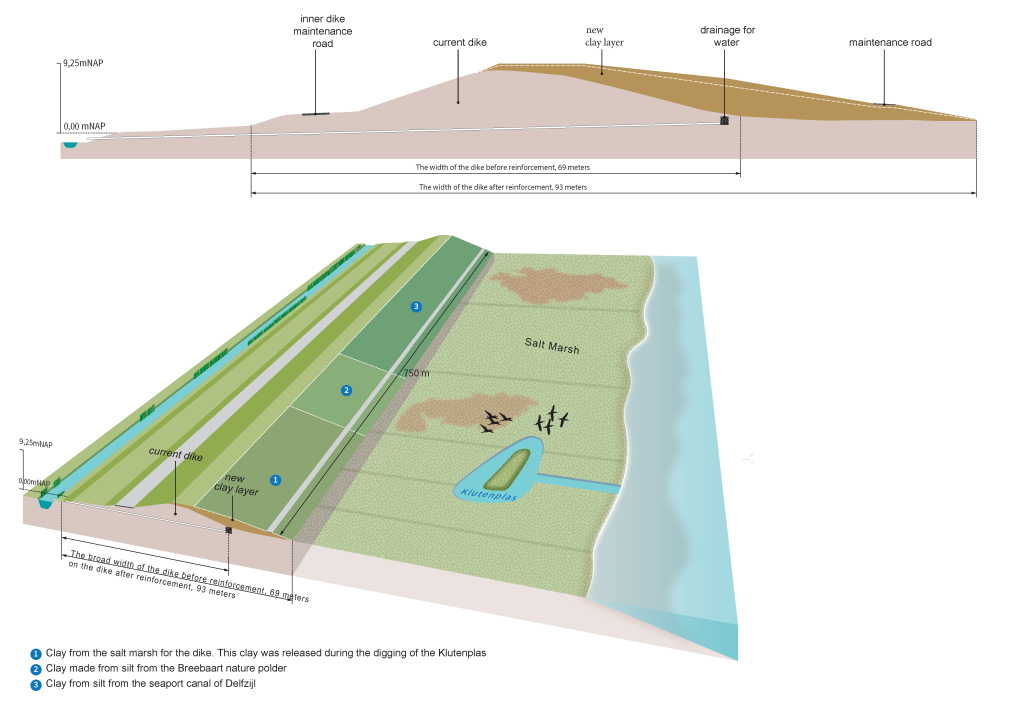Currently in the Netherlands near Delfzijl, the Brede Groene Dijk (Broad Green Dike) is being built across 750 meters with clay, which is made of dried (ripened) sediment from the nearby Eems-Dollard estuary. EcoShape carries out the work on behalf of Rijkswaterstaat and the Hunze en Aa’s water board. The National Flood Protection Program and Wadden Fund are the financiers. The project is part of the Eems-Dollard 2050 program in which the municipality of Eemsdelta is also involved and which is led by the province of Groningen.
In the Eems Dollard estuary there is too much sediment and turbidity which negatively impacts water quality. Next to that, the dikes in Groningen need to be reinforced by 2050. The ambition is to remove sediment from the water and to use it beneficially, to reinforce the dike. The alternative would be for the waterboard to buy clay from the center of the Netherlands and that would only make the land lower and wetter, while having to transport clay from farther. By ripening the sediment in local clay ripeners and using the clay to reinforce the nearby dike, there is a perfect win-win situation.
Two key leaders in this project are Technical Manager, Marcel van den Heuvel and Project Manager, Jos van Uden. EcoShape sat down with them and interviewed them on their experience in this project.

Steady project team and involvement of stakeholders creates success
Marcel shared, “The good thing is that from the clients side and also from EcoShape side, we started in 2016 and everyone is still there, which is basically unbelievable in our business because there is usually a lot of changes in project teams. It is a unique factor of this project and definitely has helped make it successful. The strength of the ”Kleirijperij” is that there are so many parties involved. On the clients side is the province, the port, the waterboard, Groninger Landschap and on EcoShapes side there are the knowledge institutes and contractors and consultants. Because there are so many people involved there is so much ownership, including institutes in charge of rules and regulations. The ownership makes everyone feel a part of it. To be honest what we are doing is not new, but what is new is the attention and the research we are demonstrating something that we actually know, but in order to change rules and regulations it needs to be done this way, involving everyone.
Challenges
As with all large-scale projects involving multiple parties there is bound to be hurdles and unexpected challenges. Marcel felt that “One challenge was working with the local community during the clay transport. Also working in a Nature2000 area, had its challenges and because we are doing something that is innovative, which often conflicts with rules and regulations. That is really what this project is about, this project is about applying clay that doesn’t follow the requirements. First we tried to make the clay fit into the requirements, but along the way we discovered we weren’t able to get the organic content and salt levels down enough.”
Looking at the molecular level
Since 2016 Marcel has seen the project develop and notes, “As a geologist I have always been involved in properties of sand, rock and clay and how that relates to our equipment, like dredging or creating islands or dikes. I have made the trip to the north many times and I have seen it changing. Every time I walk around with a shovel and take clay samples, it is interesting to see how the material evolves and changes, while having discussions on densities and clay properties and which properties are essential or not. We still have some research questions, but the real influence of organic material to clay properties is something that we looked at and will continue to. I think that for me it would be nice to look at a molecular level of what really happens. We are all civil engineers, but I think other types of expertise’s like chemists or biochemists there is something to gain by linking to other disciplines to really get to the bottom of how it works. Rock, sand, silt is all quartz material and basically sand is a small piece of rock and silt is an even smaller piece of rock. If you go to clay minerals these are completely different particles, that’s why sand and clay behave so differently when in contact with water. The ability of clay particles is so different compared to sand, which makes clay such a unique material because it has a love-hate relationship with water. If it is too dry you can’t use it and if its too wet you can’t use it, so that is the only requirement we have of the clay is that is fits that specific bandwidth that works for a dike and the water content percentage that is needed for that.”
What knowledge was gained?
As experts in the field Jos and Marcel have been working on projects similar to this for years, but there is always something that can be learned. Jos shared that even though “most of it has been just like normal building a dike, it is a little bit different because the clay doesn’t follow normal standards, but clay is clay, if it is dry enough and in the regulations this is no different than normal clay and this is important. I think it is positive that it is almost the same as nearby natural clay, that needs a few hundred years naturally, we can now make this clay in a few years. The important thing is that thinking out of the box, thinking about clay and natural ripened clay that you can make clay and you can create win-win situations.”

Application in other countries
Marcel: “I think this could work for a lot of countries as well, use local resources, make it simple and continuous, long term. For example a maintenance dredging project, keeping up with the natural infill of sediments, could be created into a circular project, beneficially reusing sediment. By making it a local process, investment can be lower, interest can be maintained and it is more realistic for continuous implementation and sustainability.”
Pilot helps imagination
“By doing this physical pilot, people can imagine how this can work in even bigger projects and this offers people something real, we have 25 football pitches with soft sediment and we are going to construct 750 meters of dike, which is substantial, its physical.” Says Marcel. “The waterboard has done a great job on the public relation aspect because they have invited so many people to visit, there are busloads of people visiting the “Kleirijperij” and this is a strength. When people visit they can see how the clay is changing and also how the process works because it is all right there. We can explain to them and they can understand because it is tangible. The scale is simply large enough that people can see what we are doing.”
Designing the dike to the clay
Despite challenges faced during the project, Marcel and Jos both believe this project can be replicated and upscaled. Marcel expressed, “I think we are changing the rules for dike construction. Changing the rules of thinking about clay requirements, means we can use clay that is available nearby, which has ecological benefits, lower CO2-footprint. Instead of using clay that fits the requirements, we design the dike that is strong enough with locally available clay. We design the dike to the clay”.
Ripen by seasons
Marcels final comments on reflecting on the project: “We said we were going to put mud in the clay ripener and ripen it in 3 years, I think the most important thing I learned is ripen by seasons. You need to only bring enough mud for that season, for example, in winter it becomes more wet and it affects the layer thickness, so think in continuous season sequence. The end goal was to apply this material into a dike and we will be successful in that this year. I think this is a big achievement.”
Multiple benefits
Jos final reflection: “The Brede Groene Dijk is not steep so you can make more use of the dike itself, not just technically strong enough, but making it big enough for a healthy diverse ecosystem and recreation area. They are not just strengthening a dike, but also enriching the area around it. Building with Nature projects can be very successful. I think the project itself is an example for other Building with Nature projects, not just the clay ripening part, but everything that makes it a success, you can use for other projects. Mainly how everyone worked together and made it a success.”
Research
EcoShape will monitor the dike in the coming three years, focusing on:
• The development of the clay over time
• Crack formation and structure formation
• Development of the grass cover on the dike
• The functioning of the drainage in the dike
• The necessary management and maintenance
The results will be used to optimize the design of the total dyke improvement, which is planned after 2025.

